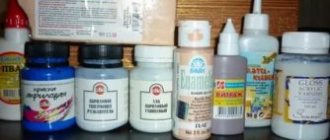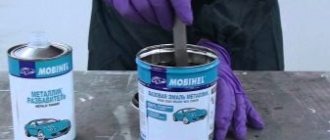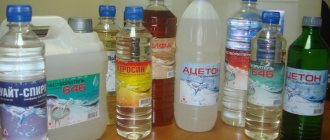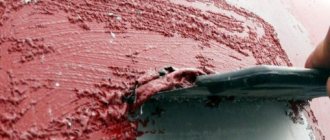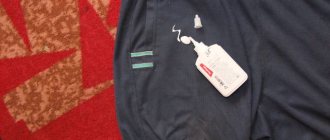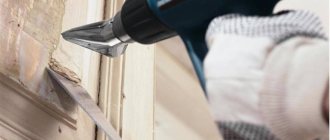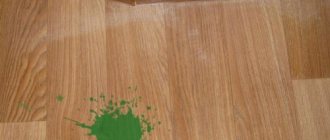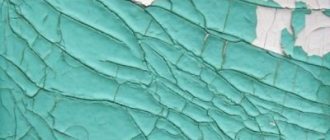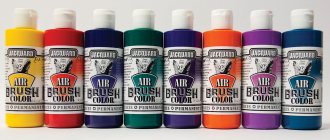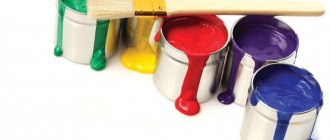Home / Lifehacks
Back
Published: 07/11/2020
Reading time: 15 min
0
6
- 1 What you need to wash it off
- 2 What is acrylic paint
- 3 Getting started with acrylic paint
- 4 Concrete
- 5 How to remove a fresh stain
- 6 Brick
- 7 Nomination “first experiments”
- 8 Features of working with acrylic
- 9 Benefits
- 10 Special and professional products
- 11 What is the reason for such a high popularity of acrylic?
What is needed to wash it off?
How to remove acrylic paint? Simple logic dictates that you need to deal with water-soluble paint stains with water. In this case, you need to take into account the time factor, how long ago the paint was applied to the surface. If the coating is fresh enough, no more than one or two hours, then the paint will be easily washed off with warm water.
As more time has passed since painting, it will be a little more difficult to remove the stains. To remove a layer of acrylic contamination from the surface you will need simple tools:
- a set of sponges for washing dishes;
- brush;
- soft napkins or rags;
- rubber gloves;
- safety glasses;
- respirator.
To wash acrylic, you will need a simple set of tools.
For cleaning, in addition to water, surfactants, solvents, gasoline, universal cleaners, and paint remover are also used.
You may need gasoline and other substances.
Acrylic facade paint is easily washed off with water, what to do.
Good day! Maybe my question will seem stupid to someone, but I don’t know much about paints, that’s why I’m asking the question on this forum, maybe someone can tell me. I painted the doors in the bathroom, as well as the legs of the wooden table, with façade acrylic paint (they said it was waterproof when I bought it). Paint Dnepro-contact. I painted it in 2-3 layers. It’s been 2 days already, in theory the paint had dried a long time ago. Today I accidentally touched the door with a wet rag, I looked and there were traces of paint on the rag. I ran a rag over the door and it washed off, and washed well. And if you run your finger along the door, a trace remains on it, i.e. the paint gets dirty. Question: is there some kind of varnish that you can use to cover the whole thing and no longer be afraid that it will wash off or stain someone’s clothes. Only one that won’t wash off all the paint. It’s a shame for the work. I am allergic to regular smelly paint, so I painted it with acrylic paint. I will be very grateful for the answer!
I'll complain too. I bought metal entrance doors with a vandal-proof coating, which was washed off by the rain. All that remains is to wash them down to the base, and then.
For your work you had to buy acrylic enamel, it is odorless and dries in an hour. They also vary greatly in price, for example, for 1 kg of Acrylic enamel Expert they ask for 180 rubles, and if you take Alpa, then for 0.5 they ask for 380 rubles. Both products are produced in Russia. And don’t go to that store where such consultants work anymore, facade paints are still created for mineral bases, and not for wood or laminated coatings. In addition, the paint was recommended to you. You can’t paint facades like this, but I’m sure the price won you over.
Before that, what were the door and legs covered with? Probably the door was painted with oil paint or PF type enamel, and the legs were varnished? Then it was impossible to expect any other result. Such surfaces for painting with acrylic need to be specially treated and primed - and then success is not guaranteed. No varnish will help. If the paint slides off the base, it will slide off along with the varnish.
Mimosa wrote: Question: is there some kind of varnish that you can use to cover the whole thing and no longer be afraid that it will wash off or stain someone’s clothes. Only one that won’t wash off all the paint. It’s a shame for the work. I am allergic to regular smelly paint, so I painted it with acrylic paint.
It’s better to wash off this Dnepro-contact and paint it with NORMAL universal moisture-resistant acrylic paint or enamel.
Yes, in Ukraine, I think it’s very difficult for me to joke with paints. I can’t even imagine how the rain could wash the coating off the meth. doors are usually painted with powder paints and baked. This coating lasts a really long time. Apparently the technological chain was broken. Well, in your case, I think such a door can easily be returned (if you cash the receipt), the door is usually guaranteed for at least a year, and you can also demand a refund of the money you spent on installation and transportation costs.
SantaChe wrote: they are usually painted with powder paints and then baked.
not a fact, they could have covered it with hammer enamel
Profan27 wrote: And before that, what were the door and legs covered with? Probably the door was painted with oil paint or PF type enamel, and the legs were varnished? Then it was impossible to expect any other result. Such surfaces for painting with acrylic need to be specially treated and primed - and then success is not guaranteed. No varnish will help. If the paint slides off the base, it will slide off along with the varnish.
Acrylic enamels sit on wound surfaces painted with oil, acrylic and alkyd enamels.
SantaChe on an unpainted surface it is enough (and not necessary) to use a primer” >
iale didn’t understand what you wanted to tell me by this, by the way, here’s a cheap and highly functional enamel for everything, so to speak. " >
SantaChe, the fact that you are promoting Descartes paints is already clear.
Mimosa wrote: I painted the doors in the bathroom, as well as the legs of the wooden table, with façade acrylic paint. Paint Dnepro-contact.
What kind of paint is the exact name? I didn’t find façade acrylic paints for wood on the website. The site only contains specialized paints for slate and zinc. I would like to see a description of the product in order to draw any conclusions. In general, water-dispersed acrylic varnishes over arkylic paints behave normally. However, polyurethane ones also behave normally. But to avoid any doubts, take a piece of a similar wooden surface, smear it with paint, then coat it with varnish and see how the paint behaves.
What is acrylic paint
In the production of the dye, a water-dispersed emulsion based on polyacrylate, a polymer material that is formed as a result of the breakdown of acrylic acid through an aqueous solution of ethanol, is used. Since acrylic is a colorless synthetic substance, colored pigments are used to obtain the required shades.
Acrylic paint is a dispersed substance based on acrylic and pigments.
To give the paint durability and strength, a film former in the form of dispersed plastic is added to the composition. Water is used as a solvent. Surfaces coated with acrylic paint are reliably protected from fading, keeping the color unchanged for a long time.
Acrylic paints are quite durable because they are protected from fading.
The main advantages of acrylic compositions, which contribute to their widespread use, include the following factors:
- easy to apply to the surface;
- there is no pungent odor that causes headaches;
- dry quickly.
Acrylic-based dyes have many advantages.
The best interior paint for the kitchen: which one to choose
With the help of paints you can create a trendy interior; they are resistant to washing, cleaning, and some even have the property of ductility, which eliminates the appearance of cracks when the house shrinks. If we consider interior mixtures according to the degree of gloss, they come in the following types:
- deep matte. Does not attract light, hides all irregularities and construction errors;
- matte. This type of material attracts more light, has a higher degree of gloss, and is able to reflect minor errors;
- semi-matte and semi-gloss. Used in small spaces. It attracts more light, which visually increases the free space.
Whatever interior mixture is used for the kitchen, it should be:
- stand;
- durable;
- with a variety of decorative solutions;
- environmentally friendly.
To paint a large surface, experts recommend correctly calculating the material consumption and purchasing directly from one manufacturer. Interior paint is sold in white, and color pigments are used to add color.
What is the best paint for kitchen walls? It depends on the personal preferences of the owner of the premises.
You should not save money, as saving leads to double expenses.
By purchasing high-quality water-based, acrylic or latex paint, you can be sure that there will be no mold, blistered coatings or fungal manifestations in the kitchen.
Matte white
Matte white paint is used to emphasize the individuality of the interior, and if applied to a textured surface, all the geometric lines will appear. The matte base can be tinted using pigment components; it visually evens out all the errors on the wall surface.
Among consumers, the following names of paints and varnishes are very popular:
- LakraRussia.
- DULUXDulux102553.
- TukkurilaTukkurila96299.
- Aura Mattlatex.
- Sweden/ESKADO2.5387.
Textured
This type of surface design has a homogeneous mass with a constructive filler.
In the kitchen, textured paint under the skillful hands of a master creates interesting patterns on the walls, as well as:
- has a high degree of durability;
- tinted at all stages of work (before and after applying the mixture);
- does not require a thoroughly cleaned surface.
Getting started with acrylic paint
You can buy acrylic paint in tubes or jars of various sizes; in tubes it is usually of a thicker consistency, in jars it is thinner. However, regardless of the thickness, upon completion of work, containers with paints must be closed with a lid very tightly, otherwise they may dry out irreversibly. The neck of the jar or tube should be freed from paint residues to prevent them from firmly adhering to the lid.
Since acrylic paint contains water, water can be used as a thinner, as well as for cleaning brushes and other tools. But you need to remember that you should wash your brushes immediately after use, otherwise they will simply become unsuitable for further use due to the already mentioned property of the paint not to react to the effects of water after drying.
If you dilute acrylic with water to a more liquid state, you can even use it in watercolor techniques. It is able to reproduce all the properties of watercolor and dry just as quickly.
In addition to water, there are many other thinners for acrylic. On sale you can find various special compositions that affect the “behavior” of paints during operation. For example, there are glossy and matte thinners, which, when dry, form a glossy and matte paint finish, respectively. There are also thinners that increase the drying time of acrylic paint, if this is necessary during the work process and to create any effects.
Acrylic can also be used as a basis for subsequent work in other techniques. For example, it is possible to prime or create a textured base with quick-drying acrylic, and then use oil paints for the classical painting technique. When combining oil and acrylic, you must remember that you should apply oil to acrylic, but not vice versa.
Immunity to the influence of weather conditions allows the use of acrylic-based compositions even outdoors. All kinds of textured acrylic gels and pastes can be used to create three-dimensional relief images. The ability to interact well with almost any surface makes acrylic suitable for painting wood, leather, fabric, ceramics, glass, earthenware and other materials.
We suggest you familiarize yourself with How to wash leatherette - jacket, bag, skirt, pants
Paints and varnishes have been used as finishing materials since ancient times. They allow you to make the interior of your home more attractive, and also protect the processed material from the harmful effects of the environment. The absolute leaders in this area are acrylic paints, the distinctive features of which we will consider in this article.
Acrylic paints in assortment
Reliable stain remover
Using a remover helps make the process of cleaning surfaces easier. This is a specially developed composition designed to remove any or only acrylic coatings. The liquid has a pungent odor and can damage the skin, so use hand and respiratory protection when working.
When cleaning the surface, perform the following actions:
- the fabric is impregnated with a remover;
- areas are treated with circular movements;
- leave the composition for 10 minutes, after which the drips and drops are wiped off with a damp cloth;
- the surface is washed with soapy foam and water.
Universal remover removes stains even after drying. It can be applied to objects made from any materials.
The effectiveness of the product does not depend on whether the paint has hardened. However, due to toxicity, the liquid should be used only in extreme cases.
Source: vmirekraski.ru
Concrete
There are several ways to clean a concrete surface from acrylic dye residues:
- Since the structure of polyacrylic is destroyed under the influence of alcohol, adding it to a soapy solution of hot water will provide an effective means for removing paint from a smooth surface.
- With no less quality results, special chemical solutions are used to wash off solvents such as 646 or acetone.
- The cheapest way is a drill with a special attachment in the form of a metal brush, which mechanically removes paint from the surface. The disadvantage of this method is a large amount of dust, so the work is carried out in safety glasses and a respirator.
Concrete can be cleaned in a variety of ways.
How to remove a fresh stain
The answer to the frequently asked question: “is acrylic paint washed off with water or not” is of course yes. Just don’t delay the procedure, because cleaning the surface from fresh stains is much easier and faster. To do this, you can use a brush or soft rag, after moistening it with water or detergent.
A fresh stain can be washed off with water.
You shouldn’t delay cleaning your clothes either, but before you wipe off the acrylic paint from the fabric, you need to do the following:
- Use a scraper (spoon, plastic card, spatula) to remove a drop of paint from the clothing.
- Turn the product inside out and soak in cold water until the stain is completely removed.
- Soak a sponge in soapy water and completely wipe off the dirt.
Cleaning clothes will require some preliminary steps.
Also, do not forget that the brush must also be cleaned after finishing work to extend its service life. First you need to soak it for a few minutes in warm water, and then thoroughly wash off the remaining paint with soap.
Brushes also need to be cleaned.
Heating as a method of removal
It is not always possible to use chemicals at home. In this case, traditional methods of removing paint from walls and other surfaces are used. You will need a hairdryer to warm up and soften the stain.
Removal is done like this:
- Contaminated areas are wiped with soapy water. A stream of hot air is directed onto the stain, and the hair dryer is held for 5-15 minutes.
- The softened paint is washed off with soap and water using a cloth. Treated areas are washed with water.
It is difficult to remove stains from clothes using this method. Porous fabric absorbs dye well. In this case, liquids for cleaning glass or plumbing are used. Instead of a hairdryer, use an iron with steaming functions. In this way you can wipe off drops of enamel from linoleum.
Brick
The most effective of all possible ways to clean a brick surface from acrylic paint contamination is the use of special chemicals to remove dyes. But first you need to clean the wall from stains of mold and mildew. This can be done by treating with lime mortar, which, after drying, is washed off with water.
The brick must first be cleaned of fungus and mold.
After which a chemically active substance is applied to the wall to remove paint. Maintain for the time specified in the instructions for use. Then the swollen paint residues are removed with a spatula and washed off with a stream of water.
A special product is applied to the brick.
Features of working with acrylic
Acrylic paints can be diluted with water or other thinners that will change their properties when drying. For example, you can add gloss by mixing with varnish or, conversely, matte with oil. You can also add shine using hairspray by sprinkling it after the paint has dried.
They can be used for priming canvases and other surfaces. Using acrylic, you can get both a smooth base and a textured one.
Advantages
- Environmentally friendly composition. There are no toxic emissions or unpleasant odors. Thanks to this, these suspensions can be safely used in rooms where children or allergy sufferers live.
Acrylic paints in a children's room
- Acceptable price. The most expensive component of most paints and varnishes is the solvent. Its absence in water-based compositions significantly reduces their cost.
- Moisture resistance. The polymers that remain after the water evaporates subsequently have very high resistance to it, reliably protecting the treated material. It also makes it possible to paint surfaces in areas with high humidity, such as the kitchen, bathroom or basement.
Bathroom painted turquoise
- Resistance to ultraviolet radiation. Constant exposure to sunlight over many years will not fade the original appearance of the acrylic coating. That is, burnout is excluded.
Even black acrylic paint will not fade if exposed to the sun all the time.
- Frost resistance. They cope well with temperatures down to -30 degrees Celsius, which allows their use for facade work.
Wooden house painted with water-dispersed composition
Advice: storing unused acrylic paints at sub-zero temperatures is strictly prohibited. Do not forget about the water base, which crystallizes in the cold, changing all the technical indicators of the suspension for the worse.
- Incredibly wide range of bright, long-lasting shades. Allows you to create an aesthetic coating that can harmonize with any interior and delight the eye for many years.
Various colors of acrylic paints
- Availability of glossy and matte paint types. Glossy ones look more attractive and bright, but are harder to maintain. Matte ones are more practical and designed for frequent washing.
Glossy suspension on the ceiling of the room
- Coloring existing shades. Thanks to the possibility of mixing, completely new and unique colors can be created, which further increase the design possibilities.
White acrylic paint mixed with yellow dye
Tip: It is recommended to use special tinting equipment for mixing. It will allow you to set the program for the result you need and repeat it if necessary. You will have to act at random with your own hands and most likely will not be able to restore the resulting color again.
We invite you to familiarize yourself with Mold under the paint
Tinting machine
- Abrasion resistance. The polymer layer perfectly withstands frequent contact with the soles of the feet or hands. So you can freely use acrylic paints for finishing floors and other frequently used surfaces.
Painting the floor with a roller
- Short curing period. Drying time for acrylic paint depends on environmental conditions. At a temperature of 20 degrees Celsius, the second layer can be applied within half an hour, and complete polymerization occurs after twelve hours.
Advice: do not use acrylic paints at temperatures below five degrees and high humidity. Since the evaporation of water in such conditions is almost impossible, and the solidification process can drag on indefinitely.
- Elasticity. Small cracks in the base, thermal expansion and possible vibrations of the treated surface will not be able to provoke cracking. This option also allows you to paint small moving parts of various designs.
- Easy to use. Do-it-yourself acrylic paints are easy to apply, forming an even, uniform layer without drips or streaks. You can use brushes, rollers or a spray gun, depending on the characteristics of the base and its area.
Applying emulsion to the wall
Tip: it’s convenient to paint especially hard-to-reach places or small objects using spray cans. Aerosol emulsions are even easier to use and can fill the deepest cracks with the finest spray.
Example of spray paint
- Vapor permeability. The treated material will be able to “breathe” freely.
- Easy to clean. How to clean acrylic paint? Resistance to alkaline influences and various types of chemicals allows the use of household chemicals to remove stains and dirt, which will allow you to always keep the painted surface clean.
- Ease of restoration. If the layer is damaged, or you are simply tired of the old shade, then you can completely repaint it over the old paint without eliminating it. So, for example, with oil paints such a trick would not work, because their surface is highly oily and does not allow high-quality polymerization of the suspension applied on top.
New paint over old coat
- No tendency to ignite. Due to their non-flammability, they significantly increase the level of fire safety of the entire building in which they are used.
- Ease of removal from tools, hands and areas not intended for painting. During work, no matter how careful you are, there is always the possibility of staining an unintended surface with paints and varnishes, but the brush and roller will be covered in paint a priori. Are acrylic paints washed off with water in such cases? Yes, a damp rag will do an ideal job of removing unwanted stains.
How to erase traces of waterborne paint
- Possibility of combination with almost any building materials.
Advice: when painting metal, be sure to carefully pre-prime it. This must be done to protect the iron from contact with water contained in the water-based emulsion and thereby prevent the appearance of corrosion.
Painting a steel roof
- Long service life. Correctly followed operating instructions guarantee at least ten years of intact paintwork that has not lost color.
What is washable wall paint
Interior paint is used for interior work. It got its name ─ washable due to the fact that it allows wet cleaning without damage, while maintaining the aesthetic appearance of the surface. It also tolerates moisture well, does not bubble, and does not leave streaks after cleaning. It can be applied to concrete, brick, plasterboard and wooden surfaces, even in the bathroom.
Characteristics
Paints and varnishes combine similar components:
- binder base;
- pigment additive;
- filler;
- special additive.
Polymer particles of the binder dissolve in water, and after it dries, stick to each other, forming a film that has good performance characteristics.
The filler is used to save pigment, impart strength and glossy shine to the base. With the help of special additives, the material quickly dries and hardens from 2 to 24 hours.
Advantages
- There are no organic solvents, so the mixture does not emit any specific odors.
- Dries quickly and forms a breathable surface.
- Environmentally safe, non-hazardous for people with allergies.
- There is a high degree of adhesion ─ adhesion.
- There is no difficulty in repainting the surface and additional treatments.
Flaws
- Dust microparticles get clogged into the matte paint. Walls need to be washed frequently and thoroughly.
- The coating does not withstand mechanical shocks.
- Single-color water-based mixtures are cold, boring tones that are best not used in living rooms. This is an option for office premises.
- Applying textured paint with stencil designs is expensive.
In what part of the apartment is it used?
A riot of bright, colored dyes are used for interior work. The main thing is to choose the right tone of material for the object in which the walls will be painted.
A bathroom in which paint will be an excellent barrier to condensation, or walls in the kitchen and hallway - the choice is only up to the owner of the room. Such surfaces are easy to keep clean: a damp cloth soaked in detergent removes all greasy stains and dirt.
What is better for the kitchen: water-based or detergent
What is the difference between water-based paint and detergent paint? The first type of material is easily washed off from the walls, and the second, stable one, is not washed off even with a chemical composition. To keep the kitchen constantly clean, there are acrylic and latex detergents. They are made using new technologies and are safe for people and the environment. You just need to wipe away any dirt with a napkin, and the walls will shine clean again.
Special and professional products
Despite the fact that acrylic dyes have a water-dispersion base, they are characterized by increased adhesion to any surface. Therefore, their removal does not always occur without complications and is limited to the use of aqueous solutions.
Sometimes you have to resort to special paint removers.
There are many special and professional products for removing acrylic paint. Among them, universal removers stand out, which are characterized by fast action, economical consumption, do not damage the surface being cleaned, act against a wide range of paints and varnishes, penetrate deeply into the surface and do not contain harmful impurities.
There are quite strong universal paint removers.
Having familiarized yourself with all the intricacies of removing acrylic contaminants from various types of surfaces, you can compare the physical and material costs of performing the work with their volume. And also choose the most effective means and method of implementation.
What is the reason for such a high popularity of acrylic?
Acrylic paints have a wide range of advantages. Combining the advantages of oil and watercolor paints, they also have their own unique characteristics. Firstly, they dry very quickly, and secondly, they have excellent covering power, and they also have incredible color brightness. The colors of the paints do not fade over time, as happens with oil paints, and do not fade in the sun, like watercolors.
As acrylic paints dry, the water contained in the composition evaporates from the painted surface, leaving behind the binder and pigment, which form a durable, elastic coating. This coating is not washed off with water; it can only be removed by applying a sufficiently strong mechanical force.
Why the coating may not wash off well
Removing stains and streaks can be difficult for the following reasons:
- Features of paint composition and coating formation. Acrylic paints consist of a water-dispersion base and polymer additives. During the drying process, a film is formed that is designed to protect the surface from the effects of negative factors. It is not easy to wash it off with water.
- Recency of application. Sometimes the brush and roller come into contact with surfaces that are not intended to be painted. You need to start cleaning within an hour. After hardening, it will not be possible to wash off drops of paint with water.

